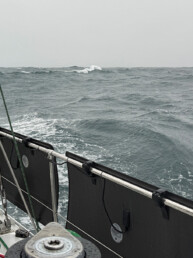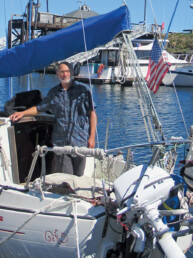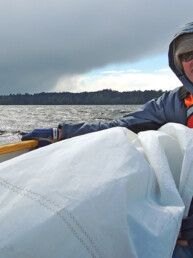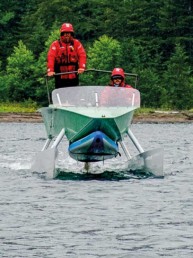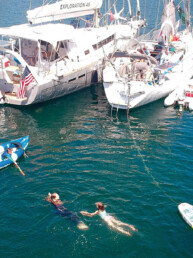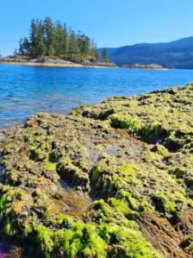48° North columnist Bruce Bateau has been sharing the story of his small boat voyage south from Port McNeil, BC to Anacortes. This story appeared in the February issue of the magazine, and you can see his next web exclusive installment on Wednesday, February 26.
Getting Underway out of Port McNeil
One of the beauties of a small boat is that you can take it almost anywhere. For me, that meant starting my Inside Passage voyage by hitching Row Bird to my friend Tim’s truck, then driving together from his home on Bainbridge Island to the Blackball ferry. Four hours later, we rolled out of the dark hold and up to the customs line in Victoria, BC.
Tim handed over our passports. The agent gave us an icy stare. “Where are you headed?”
“Port McNeil.”
Her eyes darted away for a moment, and I imagined that she was mentally reviewing the geography of the island. Port McNeil is a little fog-bound town on the north end, nearly 300 miles from Victoria.
“And what will you do up there?” she asked, seeming not to notice the boat attached to the truck.
“Well, I’ll be dropping him off,” Tim said, pointing at me. “And then he’s going to sail back to the United States.”
Her eyes turned to me. “You’re going to sail back in that boat?”
I smiled and nodded.
“And how long will that take you?” she asked, clearly trying to figure out if we were fooling with her.
“I’ve never done it, but I’m guessing about six weeks,” I replied.
At this, the agent looked even more skeptical. “And what kind of work do you do, that you can take six weeks off?”
But to this question, I knew I had a believable answer. “Bureaucrat,” I said. “I’ve had my vacation capped, and my boss told me to spend it down.”
She waved us through.
We drove north, occasionally glimpsing vast stretches of open water in the Strait of Georgia. I could barely see the other side of the strait, and glancing back at the 18-foot boat in tow, it seemed so slight, so inadequate.
Tim had offered to lend me his 22-foot pocket cruiser for my trip. With its 3-foot keel, cozy cabin (complete with a miniature woodstove), and a sculling oar, I was tempted. But when I’d sailed bigger boats in the past, I spent more time staring at the depth finder, wondering how much water was under the keel, than enjoying the scenery. I would stare up at the rigging, wondering which shroud or stay might part. And motors—is there one that is reliable in a pinch? In the end, I passed on Tim’s boat, deciding it was too big. Besides, I knew a sculling oar would be a challenge during the long stretches of still air I anticipated, and I hated the idea of having to fit the boat with a motor and listen to it roar for hours. No, despite Row Bird’s smaller size, she was the boat for me.
As Row Bird slid into the water near Port McNeil, I was grateful that it was calm, because I was not. Nervously fussing and triple-checking my gear, I found myself sweating, despite the weather, which was a mild 50 degrees and cloudy. Rationally, I had little reason to fret; I’d followed my well-honed packing system, gathered extra safety gear, and I knew every inch of Row Bird intimately. But I couldn’t help thinking about the reefs, whirlpools, and roaring currents that could cause trouble in the days ahead.
Oars have never failed me, I told myself as I rowed away from the ramp. I glanced back a few times to see what lay ahead, but once I was moving, the familiar motion generated a deep feeling of confidence.
That night, at anchor, a voice called out from the shore. “Hey, out there.”
I ignored it, assuming that someone on the beach was chatting. But the voice persisted, and I lifted the edge of my cockpit tent and waved my flashlight.
“You’re in shallow water. You’re going to hit the bottom at low tide,” he called out.
“I think I’m ok, thanks. I checked the depth. I only draw a foot.”
“No, you’re going to bottom out,” he repeated, as I turned off the light.
I awoke in the morning surrounded by water, fully afloat.
Setting sail, I headed down the broad channel of Johnstone Strait, tales of endless wind and storms lurking in the back of my mind. It was a little bumpier and significantly wider than my home waters along the Columbia River, but happily I encountered no conditions I hadn’t seen before. I turned north into a river of current within a larger channel, then caught a beam wind as I began threading through the first rocks and islands of the Broughton Archipelago.
During the planning process for this trip, I’d poured excitedly over my chart, with its hundreds of unnamed islands. Now, as the actual islands appeared ahead of me, I couldn’t suppress a giant grin of delight. Charted rocks and giant boulders became apparent as I got into the shallows, where the big boats couldn’t go. Each vertical edge hosted a fascinating community of sea creatures: twisted worms, shiny mussels, purple sea stars, luminescent anemones, and an earth-toned array of seaweeds. My oars scraped the occasional rock, but the water was so clear, that as long as a zephyr didn’t catch me, the rock gardens in the shallows would be safe and easy to navigate.
In a small boat, I had the pick of anchorages, too. I could nose into a tiny cove or anchor adjacent to a shell beach. Sometimes I’d hang out with the big boats in a popular anchorage, but more often I’d find a calm spot, just big enough for a single little boat, and swing alone.
Despite my nervous start, I slept easily over the first few nights, coming to realize that I could only worry about the challenges of the day ahead. Finding my way through dense fog, reading the chart accurately in a lumpy sea, or just staying upright in a gust, I was starting to truly understand what I already knew: with a dose of caution and good seamanship, a small boat can go almost anywhere. And I was going south next, through the current-riddled back channels along the mainland coast.
Bruce Bateau
Bruce Bateau sails and rows traditional boats with a modern twist in Portland, Ore. His stories and adventures can be found at www.terrapintales.wordpress.com

